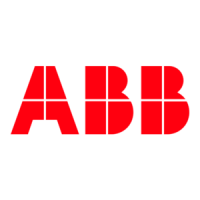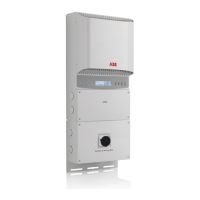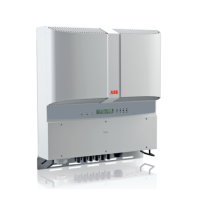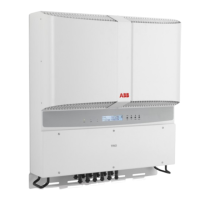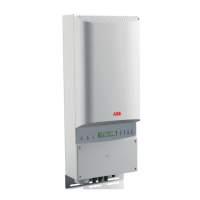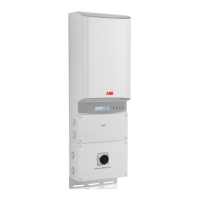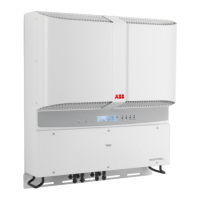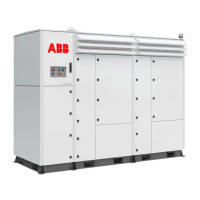Do you have a question about the ABB PVI-3.0-TL-OUTD and is the answer not in the manual?
Details warranty terms and conditions for proper equipment operation.
Information on items not provided with the equipment and ABB's non-liability.
Defines the document's scope and intended audience.
Explains the manual's purpose and organizational structure.
Outlines the necessary skills and qualifications for personnel.
Explains various symbols and safety signs used in the manual and on the equipment.
Defines the intended use, limits, and prohibited uses of the inverter.
Covers general conditions, handling, lifting, unpacking, and component checks.
Details environmental checks, position, mounting, and preparatory operations.
Explains DC input connection, polarity checks, and leakage tests.
Covers independent and parallel input channel configuration methods.
Details AC side connection, line cable sizing, and load protection.
Covers connections for communication and control board.
Describes the keyboard and LED panel functions for operation.
Covers general operational aspects and commissioning procedures.
Details user interface modes, data availability, and measurement tolerance.
Explains LED indicators, normal operation, and insulation fault indications.
Details various menus (General, Statistics, Settings, Info) and AUTOTEST procedure.
Covers routine maintenance, troubleshooting, and alarm/power limitation messages.
Provides instructions for buffer battery replacement and insulation leakage checks.
Guides on storage, decommissioning, and disposal of the equipment.
Provides an overview of equipment characteristics and technical terminology.
Details the specific models covered, their power ratings, and features like DC disconnect switch.
Explains the information found on equipment labels and approval labels.
Lists information on part identification labels for inverter and wiring box.
Provides detailed input specifications including voltage, current, and power limits.
Details output specifications like voltage, power, current, frequency, and harmonic distortion.
Covers anti-islanding, AC overcurrent protection, and output overvoltage protection.
Details efficiency, power supply threshold, night-time consumption, and communication options.
Covers ambient temperature, storage temperature, humidity, and noise emission.
Details physical dimensions, weight, assembly, safety class, and insulation.
Lists marking requirements and safety/EMC standards compliance.
Specifies compliance with various national and international grid standards.
Specifies required tightening torques for IP65 protection and optimal installation.
Provides overall dimensions of the inverter in millimeters and inches.
Details the dimensions of the wall mounting bracket.
Presents graphs of inverter efficiency curves for different models and input voltages.
Details warranty terms and conditions for proper equipment operation.
Information on items not provided with the equipment and ABB's non-liability.
Defines the document's scope and intended audience.
Explains the manual's purpose and organizational structure.
Outlines the necessary skills and qualifications for personnel.
Explains various symbols and safety signs used in the manual and on the equipment.
Defines the intended use, limits, and prohibited uses of the inverter.
Covers general conditions, handling, lifting, unpacking, and component checks.
Details environmental checks, position, mounting, and preparatory operations.
Explains DC input connection, polarity checks, and leakage tests.
Covers independent and parallel input channel configuration methods.
Details AC side connection, line cable sizing, and load protection.
Covers connections for communication and control board.
Describes the keyboard and LED panel functions for operation.
Covers general operational aspects and commissioning procedures.
Details user interface modes, data availability, and measurement tolerance.
Explains LED indicators, normal operation, and insulation fault indications.
Details various menus (General, Statistics, Settings, Info) and AUTOTEST procedure.
Covers routine maintenance, troubleshooting, and alarm/power limitation messages.
Provides instructions for buffer battery replacement and insulation leakage checks.
Guides on storage, decommissioning, and disposal of the equipment.
Provides an overview of equipment characteristics and technical terminology.
Details the specific models covered, their power ratings, and features like DC disconnect switch.
Explains the information found on equipment labels and approval labels.
Lists information on part identification labels for inverter and wiring box.
Provides detailed input specifications including voltage, current, and power limits.
Details output specifications like voltage, power, current, frequency, and harmonic distortion.
Covers anti-islanding, AC overcurrent protection, and output overvoltage protection.
Details efficiency, power supply threshold, night-time consumption, and communication options.
Covers ambient temperature, storage temperature, humidity, and noise emission.
Details physical dimensions, weight, assembly, safety class, and insulation.
Lists marking requirements and safety/EMC standards compliance.
Specifies compliance with various national and international grid standards.
Specifies required tightening torques for IP65 protection and optimal installation.
Provides overall dimensions of the inverter in millimeters and inches.
Details the dimensions of the wall mounting bracket.
Presents graphs of inverter efficiency curves for different models and input voltages.
This document serves as a product manual for ABB solar inverters, specifically the PVI-3.0/3.6/4.2-TL-OUTD series, covering models with power ratings from 3.0 kW to 4.2 kW. It provides essential information for the safe installation, operation, and maintenance of the equipment.
The ABB PVI-3.0/3.6/4.2-TL-OUTD series inverters are designed to transform direct current (DC) electricity supplied by a photovoltaic (PV) generator into alternating current (AC) electricity suitable for feeding into the public distribution grid. These are monophase string inverters, meaning they are intended for single-phase grid connections and are optimized for connecting to strings of PV modules. The inverters are available in different maximum output power variants (3.0 kW, 3.6 kW, and 4.2 kW) and may include an integrated DC disconnect switch, indicated by the "-S" suffix in the model name.
The core function of the inverter involves Maximum Power Point Tracking (MPPT) to optimize energy harvesting from the PV array. The PVI-3.0/3.6/4.2-TL-OUTD models feature two independent MPPT channels, allowing for flexible PV array configurations and improved performance in conditions where different strings might experience varying levels of irradiance or temperature. The inverter continuously monitors the grid for stability and safety, incorporating anti-islanding protection to ensure it disconnects from the grid in the event of a power outage, preventing hazardous back-feeding. It also includes ground fault detection for the photovoltaic panels to enhance safety.
The inverters are designed for outdoor installation, featuring an IP65 environmental protection rating, which ensures protection against dust ingress and low-pressure water jets from any direction. This robust design allows for reliable operation in various environmental conditions, with an ambient temperature range of -25°C to +60°C. Natural cooling is employed, eliminating the need for active fans and contributing to quieter operation, with a typical noise emission pressure of 50 dB(A) at 1 meter.
User interaction is facilitated through an integrated LCD display with 16 characters x 2 lines and a keyboard. This interface allows operators to monitor data, access various menus, and adjust settings. The display provides information on general operating conditions, statistics, and system settings. The manual emphasizes that only qualified personnel should perform installation and maintenance, while general operation can be managed through the user interface.
For connectivity and monitoring, the inverters offer several options. Wired local monitoring can be achieved via PVI-USB-RS232_485 (optional). Remote monitoring capabilities are supported through optional accessories like the VSN300 Wifi Logger Card, PVI-AEC-EVO, or VSN700 Data Logger. These options enable users to track the inverter's performance and energy production remotely. The communication and control board also supports serial communication (RS485) for integration with monitoring systems and includes configurable relay connections for alarm signals.
The installation process involves wall/pole mounting, with detailed instructions provided for preparing the PV generator connection, checking polarity, and ensuring proper grounding. The input connections to the PV generator (DC side) utilize quick-fit connectors, simplifying the wiring process. The grid output connection (AC side) uses a screw terminal block, and guidelines are given for cable sizing and load protection switches.
The manual outlines important safety instructions that must be followed during installation and maintenance. It stresses that ABB is not responsible for damages resulting from non-compliance with these instructions or unauthorized modifications. The warranty conditions are contingent upon adherence to the manual's guidelines.
Routine maintenance is covered, including troubleshooting procedures and explanations of alarm messages and power limitation messages that may appear on the display. The manual provides guidance on how to interpret these messages and what actions to take. For more advanced maintenance, such as resetting the time remaining to change the grid standard or replacing the buffer battery, specific procedures are detailed.
A critical maintenance aspect is the verification of ground leakage and measuring the insulation resistance of the photovoltaic generator. The manual describes the behavior of the system with and without leakage and provides instructions for performing insulation resistance measurements to ensure continued safe operation.
The document also addresses storage and dismantling procedures, including guidelines for storing the equipment during long periods of non-use and instructions for decommissioning and proper disposal of the inverter and its components, particularly substances potentially harmful to the environment, in accordance with local legislation. The manual explicitly states that ABB is not responsible for the disposal of items like displays, cables, batteries, and accumulators, placing this responsibility on the customer.
Overall, the manual aims to provide comprehensive guidance to ensure the longevity and safe operation of the ABB PVI-3.0/3.6/4.2-TL-OUTD solar inverters.
| Model | PVI-3.0-TL-OUTD |
|---|---|
| Rated Power | 3000 W |
| Max. DC Voltage | 600 V |
| Nominal AC Power | 3000 W |
| Max. AC Power | 3000 W |
| Nominal AC Voltage | 230 V |
| Max. AC Current | 13 A |
| European Efficiency | 95.5% |
| Dimensions | 553 x 418 x 175 mm |
| Weight | 18 kg |
| Protection Degree | IP65 |
| Operating Temperature Range | -25°C to +60°C |
| Cooling Method | Natural Convection |
| Number of MPP Trackers | 1 |
| Maximum Input Voltage | 600 V |
| Frequency Range | 50/60 Hz |
| Max Efficiency | 96.8% |
| Type | Transformerless |
| AC Voltage Range | 180-276 V |
